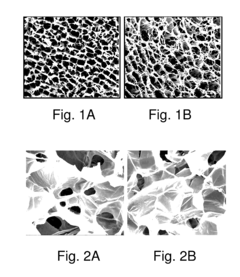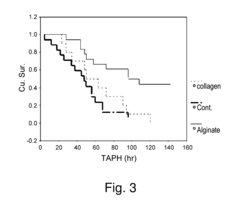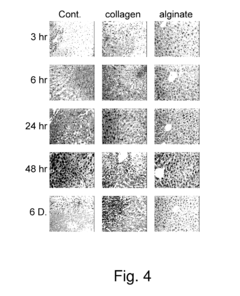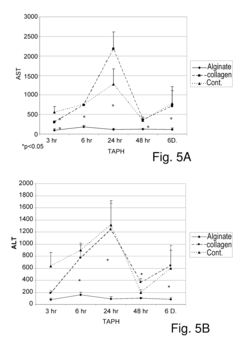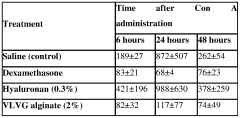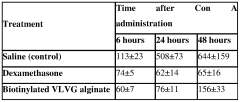How to Apply Sodium Alginate in Low-Calorie Cooking Solutions?
JUL 14, 20259 MIN READ
Generate Your Research Report Instantly with AI Agent
Patsnap Eureka helps you evaluate technical feasibility & market potential.
Sodium Alginate in Culinary Innovation
Sodium alginate, a versatile compound derived from brown algae, has emerged as a groundbreaking ingredient in the realm of culinary innovation, particularly in the development of low-calorie cooking solutions. This natural polysaccharide possesses unique gelling properties that have captivated the attention of chefs, food scientists, and health-conscious consumers alike.
The application of sodium alginate in low-calorie cooking solutions represents a convergence of molecular gastronomy and health-oriented cuisine. Its ability to form gels in the presence of calcium ions has opened up a world of possibilities for creating textures and structures that were previously unattainable in low-calorie foods. This innovation has allowed chefs to reimagine traditional dishes, reducing caloric content while maintaining satisfying mouthfeel and flavor profiles.
One of the most notable applications of sodium alginate in low-calorie cooking is the technique of spherification. This process involves encapsulating liquids in a thin, gel-like membrane, creating caviar-like spheres that burst with flavor upon consumption. By using low-calorie liquids or purees, chefs can create visually stunning and texturally interesting garnishes and components that add minimal calories to a dish.
Another innovative use of sodium alginate is in the creation of low-calorie noodles and pasta alternatives. By combining the compound with water and calcium chloride, it's possible to form gel-like strands that mimic the texture of traditional pasta but contain significantly fewer calories. This application has been particularly popular in the development of gluten-free and low-carbohydrate meal options.
In the realm of desserts and confectionery, sodium alginate has enabled the creation of low-calorie jellies, gummies, and other sweet treats. By replacing high-calorie ingredients like sugar and fat with alginate-based gels, confectioners can produce products that satisfy sweet cravings without the associated caloric load. This has been particularly beneficial in the development of diabetic-friendly sweets and weight management products.
The use of sodium alginate in emulsions and foams has also contributed to low-calorie cooking innovations. By stabilizing air or water-based emulsions, chefs can create light, airy textures that impart a sense of richness and indulgence without the need for high-fat ingredients. This technique has been successfully applied in the creation of low-calorie mousses, whipped toppings, and even "faux" butter alternatives.
As the demand for healthier food options continues to grow, the role of sodium alginate in culinary innovation is likely to expand further. Its versatility, combined with ongoing research into its properties and applications, positions it as a key ingredient in the future of low-calorie cooking solutions. The challenge for chefs and food scientists moving forward will be to continue pushing the boundaries of what's possible with this remarkable compound, creating ever more sophisticated and appealing low-calorie options for health-conscious consumers.
The application of sodium alginate in low-calorie cooking solutions represents a convergence of molecular gastronomy and health-oriented cuisine. Its ability to form gels in the presence of calcium ions has opened up a world of possibilities for creating textures and structures that were previously unattainable in low-calorie foods. This innovation has allowed chefs to reimagine traditional dishes, reducing caloric content while maintaining satisfying mouthfeel and flavor profiles.
One of the most notable applications of sodium alginate in low-calorie cooking is the technique of spherification. This process involves encapsulating liquids in a thin, gel-like membrane, creating caviar-like spheres that burst with flavor upon consumption. By using low-calorie liquids or purees, chefs can create visually stunning and texturally interesting garnishes and components that add minimal calories to a dish.
Another innovative use of sodium alginate is in the creation of low-calorie noodles and pasta alternatives. By combining the compound with water and calcium chloride, it's possible to form gel-like strands that mimic the texture of traditional pasta but contain significantly fewer calories. This application has been particularly popular in the development of gluten-free and low-carbohydrate meal options.
In the realm of desserts and confectionery, sodium alginate has enabled the creation of low-calorie jellies, gummies, and other sweet treats. By replacing high-calorie ingredients like sugar and fat with alginate-based gels, confectioners can produce products that satisfy sweet cravings without the associated caloric load. This has been particularly beneficial in the development of diabetic-friendly sweets and weight management products.
The use of sodium alginate in emulsions and foams has also contributed to low-calorie cooking innovations. By stabilizing air or water-based emulsions, chefs can create light, airy textures that impart a sense of richness and indulgence without the need for high-fat ingredients. This technique has been successfully applied in the creation of low-calorie mousses, whipped toppings, and even "faux" butter alternatives.
As the demand for healthier food options continues to grow, the role of sodium alginate in culinary innovation is likely to expand further. Its versatility, combined with ongoing research into its properties and applications, positions it as a key ingredient in the future of low-calorie cooking solutions. The challenge for chefs and food scientists moving forward will be to continue pushing the boundaries of what's possible with this remarkable compound, creating ever more sophisticated and appealing low-calorie options for health-conscious consumers.
Market Trends in Low-Calorie Foods
The low-calorie food market has experienced significant growth in recent years, driven by increasing health consciousness among consumers and rising obesity rates globally. This trend is expected to continue, with the global low-calorie food market projected to expand at a compound annual growth rate (CAGR) of 5.9% from 2021 to 2028. The market is primarily fueled by the growing demand for healthier food options, particularly in developed countries where lifestyle-related diseases are prevalent.
One of the key factors contributing to this market growth is the shift in consumer preferences towards healthier eating habits. As awareness of the link between diet and health increases, more consumers are actively seeking out low-calorie alternatives to their favorite foods. This has led to a surge in demand for products that offer reduced calorie content without compromising on taste or texture.
The food and beverage industry has responded to this trend by developing a wide range of low-calorie products across various categories. These include low-calorie beverages, snacks, dairy products, and ready-to-eat meals. Many major food manufacturers have invested heavily in research and development to create innovative low-calorie formulations that meet consumer expectations for taste and nutritional value.
In the beverage sector, there has been a notable shift towards low-calorie and zero-calorie options. The market for diet sodas, flavored water, and low-calorie energy drinks has expanded significantly. Similarly, in the snack food category, manufacturers are introducing low-calorie versions of popular snacks, often utilizing alternative ingredients or production methods to reduce calorie content while maintaining flavor profiles.
The dairy industry has also embraced the low-calorie trend, with an increasing number of low-fat and fat-free milk products, yogurts, and cheese alternatives entering the market. These products often incorporate innovative ingredients or processing techniques to achieve a desirable texture and taste while reducing calorie content.
Another important trend in the low-calorie food market is the growing demand for natural and clean-label products. Consumers are not only looking for reduced calorie options but also products that are free from artificial ingredients, preservatives, and additives. This has led to the development of low-calorie foods that utilize natural sweeteners, such as stevia, and other plant-based ingredients to achieve calorie reduction without relying on synthetic compounds.
The market for low-calorie cooking solutions, including ingredients like sodium alginate, is also expanding. These ingredients are gaining popularity among health-conscious consumers and food manufacturers alike, as they offer ways to reduce calorie content in home-cooked meals and packaged foods while maintaining desirable textures and flavors.
One of the key factors contributing to this market growth is the shift in consumer preferences towards healthier eating habits. As awareness of the link between diet and health increases, more consumers are actively seeking out low-calorie alternatives to their favorite foods. This has led to a surge in demand for products that offer reduced calorie content without compromising on taste or texture.
The food and beverage industry has responded to this trend by developing a wide range of low-calorie products across various categories. These include low-calorie beverages, snacks, dairy products, and ready-to-eat meals. Many major food manufacturers have invested heavily in research and development to create innovative low-calorie formulations that meet consumer expectations for taste and nutritional value.
In the beverage sector, there has been a notable shift towards low-calorie and zero-calorie options. The market for diet sodas, flavored water, and low-calorie energy drinks has expanded significantly. Similarly, in the snack food category, manufacturers are introducing low-calorie versions of popular snacks, often utilizing alternative ingredients or production methods to reduce calorie content while maintaining flavor profiles.
The dairy industry has also embraced the low-calorie trend, with an increasing number of low-fat and fat-free milk products, yogurts, and cheese alternatives entering the market. These products often incorporate innovative ingredients or processing techniques to achieve a desirable texture and taste while reducing calorie content.
Another important trend in the low-calorie food market is the growing demand for natural and clean-label products. Consumers are not only looking for reduced calorie options but also products that are free from artificial ingredients, preservatives, and additives. This has led to the development of low-calorie foods that utilize natural sweeteners, such as stevia, and other plant-based ingredients to achieve calorie reduction without relying on synthetic compounds.
The market for low-calorie cooking solutions, including ingredients like sodium alginate, is also expanding. These ingredients are gaining popularity among health-conscious consumers and food manufacturers alike, as they offer ways to reduce calorie content in home-cooked meals and packaged foods while maintaining desirable textures and flavors.
Current Applications and Limitations
Sodium alginate has gained significant attention in the culinary world, particularly in the realm of low-calorie cooking solutions. Currently, this versatile ingredient is widely used in molecular gastronomy and as a thickening agent in various food products. In molecular gastronomy, sodium alginate is employed to create spherification, a technique that transforms liquids into gel-like spheres with a thin membrane. This application allows chefs to create innovative textures and presentations while maintaining low calorie content.
In the food industry, sodium alginate serves as a stabilizer and emulsifier in products such as ice cream, yogurt, and salad dressings. Its ability to form gels and increase viscosity without adding significant calories makes it an attractive option for manufacturers seeking to reduce fat content while maintaining desirable textures. Additionally, sodium alginate is used in the production of low-calorie beverages, where it helps to improve mouthfeel and stability without contributing to the caloric value.
Despite its widespread use, sodium alginate faces certain limitations in low-calorie cooking applications. One primary challenge is its sensitivity to pH levels, which can affect its gelling properties. In highly acidic environments, sodium alginate may not form stable gels, limiting its use in certain recipes. Furthermore, the texture produced by sodium alginate gels may not always perfectly mimic the mouthfeel of traditional high-calorie ingredients, potentially impacting consumer acceptance in some applications.
Another limitation is the need for precise measurements and careful handling during the cooking process. Incorrect ratios or improper mixing techniques can lead to inconsistent results, making it challenging for home cooks to achieve desired outcomes consistently. Additionally, the availability of sodium alginate for home use may be limited compared to professional culinary settings, potentially restricting its widespread adoption in everyday low-calorie cooking.
The cost of sodium alginate, while not prohibitively expensive, may be higher than traditional thickening agents, which could impact its adoption in large-scale food production. Moreover, consumer perception and acceptance of "chemical-sounding" ingredients like sodium alginate in their food products can pose a challenge, particularly in markets where there is a growing demand for "clean label" and natural ingredients.
Lastly, regulatory considerations and labeling requirements for sodium alginate vary across different regions, which can complicate its use in global food products. Some countries may have restrictions on the types of foods in which sodium alginate can be used or require specific labeling when it is present in a product. These regulatory challenges can limit the widespread application of sodium alginate in certain markets or product categories.
In the food industry, sodium alginate serves as a stabilizer and emulsifier in products such as ice cream, yogurt, and salad dressings. Its ability to form gels and increase viscosity without adding significant calories makes it an attractive option for manufacturers seeking to reduce fat content while maintaining desirable textures. Additionally, sodium alginate is used in the production of low-calorie beverages, where it helps to improve mouthfeel and stability without contributing to the caloric value.
Despite its widespread use, sodium alginate faces certain limitations in low-calorie cooking applications. One primary challenge is its sensitivity to pH levels, which can affect its gelling properties. In highly acidic environments, sodium alginate may not form stable gels, limiting its use in certain recipes. Furthermore, the texture produced by sodium alginate gels may not always perfectly mimic the mouthfeel of traditional high-calorie ingredients, potentially impacting consumer acceptance in some applications.
Another limitation is the need for precise measurements and careful handling during the cooking process. Incorrect ratios or improper mixing techniques can lead to inconsistent results, making it challenging for home cooks to achieve desired outcomes consistently. Additionally, the availability of sodium alginate for home use may be limited compared to professional culinary settings, potentially restricting its widespread adoption in everyday low-calorie cooking.
The cost of sodium alginate, while not prohibitively expensive, may be higher than traditional thickening agents, which could impact its adoption in large-scale food production. Moreover, consumer perception and acceptance of "chemical-sounding" ingredients like sodium alginate in their food products can pose a challenge, particularly in markets where there is a growing demand for "clean label" and natural ingredients.
Lastly, regulatory considerations and labeling requirements for sodium alginate vary across different regions, which can complicate its use in global food products. Some countries may have restrictions on the types of foods in which sodium alginate can be used or require specific labeling when it is present in a product. These regulatory challenges can limit the widespread application of sodium alginate in certain markets or product categories.
Sodium Alginate Cooking Techniques
01 Low-calorie food products containing sodium alginate
Sodium alginate is used in the formulation of low-calorie food products. It acts as a thickening agent and stabilizer, providing texture and mouthfeel without adding significant calories. These products cater to health-conscious consumers seeking reduced-calorie options while maintaining desirable sensory properties.- Low-calorie food products containing sodium alginate: Sodium alginate is used in the formulation of low-calorie food products due to its ability to form gels and act as a thickening agent. It can be used to create textures similar to high-calorie foods while reducing overall caloric content. This makes it useful in diet foods and beverages.
- Sodium alginate as a dietary fiber supplement: Sodium alginate is considered a dietary fiber and can be used as a supplement to increase fiber intake. It has minimal caloric value while providing bulk to the diet, which can aid in digestion and promote feelings of fullness. This property makes it beneficial for weight management and digestive health.
- Calorie reduction in beverages using sodium alginate: Sodium alginate can be used to reduce calories in beverages by replacing high-calorie ingredients or by creating a thicker mouthfeel without adding significant calories. This allows for the production of low-calorie drinks that maintain desirable sensory properties.
- Sodium alginate in calorie-controlled medical nutrition: In medical nutrition applications, sodium alginate is used to create calorie-controlled formulations for patients with specific dietary needs. It can help in managing calorie intake while providing necessary nutrients, making it valuable in enteral nutrition and specialized diet plans.
- Encapsulation of active ingredients using sodium alginate: Sodium alginate is used for encapsulating active ingredients in the food and pharmaceutical industries. This technique can help control the release of nutrients or drugs, potentially affecting their caloric impact and bioavailability. It allows for the development of functional foods and targeted delivery systems.
02 Sodium alginate as a dietary fiber supplement
Sodium alginate is utilized as a dietary fiber supplement due to its low caloric content and potential health benefits. It can help increase satiety, improve digestive health, and may contribute to weight management. The incorporation of sodium alginate in various food and beverage products can enhance their nutritional profile.Expand Specific Solutions03 Calorie reduction in beverages using sodium alginate
Sodium alginate is employed in the formulation of reduced-calorie beverages. It can be used to create low-calorie, gel-like structures or as a thickening agent to improve mouthfeel and texture in drinks with reduced sugar content. This application allows for the development of healthier beverage options without compromising taste or consistency.Expand Specific Solutions04 Sodium alginate in calorie-controlled medical nutrition
Sodium alginate is utilized in the development of calorie-controlled medical nutrition products. These formulations are designed for patients with specific dietary requirements or those needing to manage their caloric intake. The low-calorie nature of sodium alginate makes it suitable for creating nutritionally balanced meals and supplements for medical purposes.Expand Specific Solutions05 Encapsulation of active ingredients using sodium alginate
Sodium alginate is used in the encapsulation of active ingredients for various applications, including controlled release of nutrients or pharmaceuticals. This technique can be employed to develop low-calorie functional foods or supplements, where the encapsulated ingredients are protected and released in a controlled manner, potentially influencing the overall caloric content of the product.Expand Specific Solutions
Key Players in Food Technology
The application of sodium alginate in low-calorie cooking solutions is an emerging field within the food industry, currently in its growth phase. The market for this technology is expanding, driven by increasing consumer demand for healthier food options. The global market size for sodium alginate in food applications is projected to grow significantly in the coming years. Technologically, the use of sodium alginate in low-calorie cooking is advancing, with companies like Qingdao Bright Moon Seaweed Group and J. Rettenmaier & Söhne leading research and development efforts. Academic institutions such as Ocean University of China and Norwegian University of Science & Technology are also contributing to the technological maturity of this field through scientific research and innovation.
Qingdao Bright Moon Seaweed Group Co., Ltd.
Technical Solution: Qingdao Bright Moon Seaweed Group has developed a range of sodium alginate products specifically tailored for low-calorie cooking solutions. Their approach involves using sodium alginate as a thickening and gelling agent in reduced-calorie food formulations. The company has created a proprietary process to extract high-quality sodium alginate from brown seaweed, ensuring optimal functionality in food applications[1]. Their sodium alginate products are designed to provide texture and mouthfeel similar to full-fat products while significantly reducing calorie content. The company has also developed specialized blends of sodium alginate with other hydrocolloids to enhance stability and improve sensory properties in low-calorie foods[2].
Strengths: Extensive experience in seaweed-derived ingredients, specialized sodium alginate products for food applications, and proprietary extraction process. Weaknesses: May face competition from synthetic alternatives and potential supply chain challenges due to reliance on seaweed harvests.
Ocean University of China
Technical Solution: Ocean University of China has conducted extensive research on the application of sodium alginate in low-calorie cooking solutions. Their approach focuses on the molecular gastronomy aspect, utilizing sodium alginate's unique gelling properties to create innovative, low-calorie food textures. The university's food science department has developed a method to create flavorful, low-calorie spherifications using sodium alginate, which can be used as garnishes or flavor bursts in various dishes[3]. Additionally, they have explored the use of sodium alginate as a fat replacer in baked goods and dairy products, achieving up to 30% calorie reduction without significant impact on taste or texture[4]. The research team has also investigated the synergistic effects of combining sodium alginate with other natural fibers to enhance satiety in low-calorie meals.
Strengths: Strong research capabilities, innovative applications in molecular gastronomy, and focus on practical food industry applications. Weaknesses: May face challenges in scaling up research findings for commercial production and potential limitations in funding for extensive clinical trials.
Innovative Uses in Molecular Gastronomy
Alginate biomaterials for the treatment of hepatic disorders
PatentActiveUS20160317570A1
Innovation
- The use of biocompatible alginate biomaterials in solid, hydrogel, or solution forms, which can be systemically or locally administered, providing a scaffold for tissue repair and regeneration without the need for additional cross-linking agents, promoting cell adhesion and vascularization, and supporting liver function recovery.
Alginate compositions and uses thereof
PatentWO2014102802A1
Innovation
- A novel alginate composition characterized by specific physical properties, including a zeta potential weaker than -25 mV and a diffusion coefficient of at least 10^-8 cm^2/millisecond, is administered to enhance its therapeutic effectiveness in treating hepatic diseases and reducing liver damage, either alone or in conjunction with hepatotoxic agents.
Regulatory Framework for Food Additives
The regulatory framework for food additives plays a crucial role in ensuring the safety and proper use of substances like sodium alginate in low-calorie cooking solutions. In the United States, the Food and Drug Administration (FDA) oversees the regulation of food additives, including sodium alginate, under the Federal Food, Drug, and Cosmetic Act (FD&C Act).
Sodium alginate is classified as a Generally Recognized as Safe (GRAS) substance by the FDA, which means it is considered safe for use in food products when used in accordance with good manufacturing practices. The FDA has established specific guidelines for the use of sodium alginate in various food applications, including its use as a thickening agent, stabilizer, and emulsifier.
In the European Union, the European Food Safety Authority (EFSA) is responsible for evaluating the safety of food additives. Sodium alginate is approved for use in the EU under the E-number E401. The EFSA has conducted comprehensive safety assessments of sodium alginate and established acceptable daily intake (ADI) levels for its consumption.
The Codex Alimentarius Commission, a joint initiative of the Food and Agriculture Organization (FAO) and the World Health Organization (WHO), provides international food standards that serve as a reference for many countries. The Codex General Standard for Food Additives (GSFA) includes provisions for the use of sodium alginate in various food categories.
When applying sodium alginate in low-calorie cooking solutions, manufacturers must adhere to the specific regulations and guidelines set forth by the relevant regulatory bodies. This includes compliance with maximum usage levels, labeling requirements, and any restrictions on the types of food products in which sodium alginate can be used.
It is important to note that regulatory frameworks for food additives can vary between countries and regions. Manufacturers and food producers must ensure compliance with local regulations when developing and marketing low-calorie cooking solutions containing sodium alginate.
Regular monitoring and updates to the regulatory framework are essential to address new scientific findings and ensure the continued safety of food additives. Regulatory bodies periodically review and update their guidelines based on emerging research and risk assessments.
As the demand for low-calorie cooking solutions continues to grow, regulatory agencies may need to adapt their frameworks to accommodate innovative uses of sodium alginate and other food additives. This may involve conducting additional safety assessments, revising usage limits, or expanding the scope of approved applications.
Sodium alginate is classified as a Generally Recognized as Safe (GRAS) substance by the FDA, which means it is considered safe for use in food products when used in accordance with good manufacturing practices. The FDA has established specific guidelines for the use of sodium alginate in various food applications, including its use as a thickening agent, stabilizer, and emulsifier.
In the European Union, the European Food Safety Authority (EFSA) is responsible for evaluating the safety of food additives. Sodium alginate is approved for use in the EU under the E-number E401. The EFSA has conducted comprehensive safety assessments of sodium alginate and established acceptable daily intake (ADI) levels for its consumption.
The Codex Alimentarius Commission, a joint initiative of the Food and Agriculture Organization (FAO) and the World Health Organization (WHO), provides international food standards that serve as a reference for many countries. The Codex General Standard for Food Additives (GSFA) includes provisions for the use of sodium alginate in various food categories.
When applying sodium alginate in low-calorie cooking solutions, manufacturers must adhere to the specific regulations and guidelines set forth by the relevant regulatory bodies. This includes compliance with maximum usage levels, labeling requirements, and any restrictions on the types of food products in which sodium alginate can be used.
It is important to note that regulatory frameworks for food additives can vary between countries and regions. Manufacturers and food producers must ensure compliance with local regulations when developing and marketing low-calorie cooking solutions containing sodium alginate.
Regular monitoring and updates to the regulatory framework are essential to address new scientific findings and ensure the continued safety of food additives. Regulatory bodies periodically review and update their guidelines based on emerging research and risk assessments.
As the demand for low-calorie cooking solutions continues to grow, regulatory agencies may need to adapt their frameworks to accommodate innovative uses of sodium alginate and other food additives. This may involve conducting additional safety assessments, revising usage limits, or expanding the scope of approved applications.
Nutritional Impact Assessment
The application of sodium alginate in low-calorie cooking solutions presents significant implications for nutritional impact. This natural polysaccharide, derived from brown algae, has gained attention in the culinary world for its unique gelling properties and potential to create innovative, low-calorie dishes.
Sodium alginate's primary nutritional benefit lies in its low caloric content. As a dietary fiber, it contributes minimal calories while providing a sense of fullness, potentially aiding in weight management efforts. This characteristic makes it an attractive ingredient for individuals seeking to reduce their caloric intake without compromising on texture or mouthfeel in their meals.
Furthermore, the use of sodium alginate in low-calorie cooking can lead to a reduction in the overall fat content of dishes. By creating gels and emulsions, it can mimic the creamy textures typically associated with high-fat ingredients, allowing for the development of healthier alternatives to traditional recipes. This substitution can contribute to a lower overall calorie density in meals, supporting dietary goals for weight loss or maintenance.
The incorporation of sodium alginate may also have positive effects on glycemic response. As a soluble fiber, it can slow down the digestion and absorption of carbohydrates, potentially leading to more stable blood sugar levels. This property could be particularly beneficial for individuals managing diabetes or those aiming to improve their overall metabolic health.
Additionally, sodium alginate has been shown to have prebiotic properties, potentially supporting gut health by promoting the growth of beneficial bacteria in the digestive system. A healthy gut microbiome is increasingly recognized as a crucial factor in overall nutrition and well-being.
However, it is important to consider potential drawbacks in the nutritional impact of sodium alginate use. While generally recognized as safe, excessive consumption may lead to reduced absorption of certain minerals due to its binding properties. This effect could be mitigated through careful formulation and balanced meal planning.
In conclusion, the application of sodium alginate in low-calorie cooking solutions offers promising nutritional benefits, primarily through calorie reduction, improved satiety, and potential positive impacts on glycemic control and gut health. As with any novel ingredient, further research and long-term studies will be crucial to fully understand its nutritional impact and optimize its use in dietary applications.
Sodium alginate's primary nutritional benefit lies in its low caloric content. As a dietary fiber, it contributes minimal calories while providing a sense of fullness, potentially aiding in weight management efforts. This characteristic makes it an attractive ingredient for individuals seeking to reduce their caloric intake without compromising on texture or mouthfeel in their meals.
Furthermore, the use of sodium alginate in low-calorie cooking can lead to a reduction in the overall fat content of dishes. By creating gels and emulsions, it can mimic the creamy textures typically associated with high-fat ingredients, allowing for the development of healthier alternatives to traditional recipes. This substitution can contribute to a lower overall calorie density in meals, supporting dietary goals for weight loss or maintenance.
The incorporation of sodium alginate may also have positive effects on glycemic response. As a soluble fiber, it can slow down the digestion and absorption of carbohydrates, potentially leading to more stable blood sugar levels. This property could be particularly beneficial for individuals managing diabetes or those aiming to improve their overall metabolic health.
Additionally, sodium alginate has been shown to have prebiotic properties, potentially supporting gut health by promoting the growth of beneficial bacteria in the digestive system. A healthy gut microbiome is increasingly recognized as a crucial factor in overall nutrition and well-being.
However, it is important to consider potential drawbacks in the nutritional impact of sodium alginate use. While generally recognized as safe, excessive consumption may lead to reduced absorption of certain minerals due to its binding properties. This effect could be mitigated through careful formulation and balanced meal planning.
In conclusion, the application of sodium alginate in low-calorie cooking solutions offers promising nutritional benefits, primarily through calorie reduction, improved satiety, and potential positive impacts on glycemic control and gut health. As with any novel ingredient, further research and long-term studies will be crucial to fully understand its nutritional impact and optimize its use in dietary applications.
Unlock deeper insights with Patsnap Eureka Quick Research — get a full tech report to explore trends and direct your research. Try now!
Generate Your Research Report Instantly with AI Agent
Supercharge your innovation with Patsnap Eureka AI Agent Platform!
